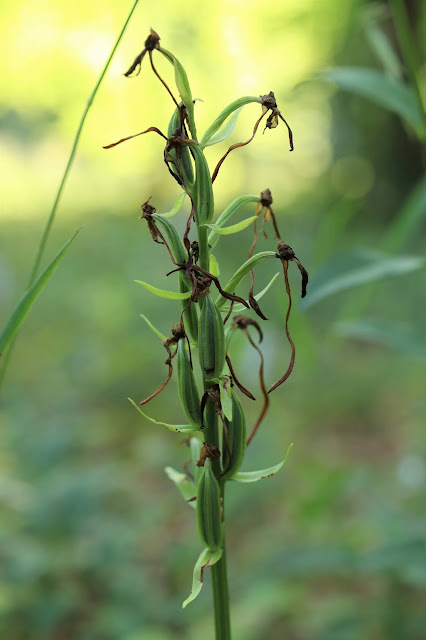Last Friday I went to the farm near Christmas Common to check on the greater butterfly orchids there. 4 out of the 10 plants I checked were appearing above ground; one had reached 2 cm high. They are roughly at the same stage as they were 12 months ago, and before snails created havoc.
 |
| Plant #214 |
 |
| Plant #111 |
 |
| Plant #89 |
The Christmas Common population is probably the largest in Oxfordshire, but greater butterfly orchid is probably declining in Oxfordshire and indeed more widely.
The study there is to look at population dynamics but more generally I am trying to better understand whether orchids are becoming rarer, as seems to be the case, and if so why. For example, BBOWT has long term datasets at its Warburg reserve, and for several species the numbers have fallen in recent years. Two species are no longer found there.
To look at whether orchid species are disappearing in the county I analysed BSBI's records for Oxfordshire (or rather more precisely that bit of the administrative county covered by BSBI's Vice County 23) to determine if orchids are less common than they were 50 years ago. A limitation is that BSBI's data gives localities but not abundance (a locality with 1 plant has the same weight as another with hundreds), but nevertheless I thought the crude analysis of occurrence would be still be meaningful.
I split the records into decades, from which I then determined how many species were present in each decade and in how many monads i.e.1 km squares (botanists would not be top of the list at Plain English awards), each species was present to give some idea of how rare or otherwise a species might be. I took the data that was there without any amendment or refinement.
The number of records per decade and the number of recorders who provided those records were:
- 1970-9 954 records 186 recorders
- 1980-9 833 records 74 recorders
- 1990-9 494 records 167 recorders
- 2000-9 936 records 170 recorders
- 2010-9 1597 records 239 recorders
The rise in activity in the last decade is due to the increased BSBI effort to underpin its Atlas 2020 which will be published in a couple of years or so.
The number of species found in the county has fallen:
- 1970-9 31 species
- 1980-9 29 species
- 1990-9 28 species
- 2000-9 28 species
- 2010-9 26 species
We have lost ghost orchid (not seen anywhere in the UK since 2009, and declining in Europe), musk and burnt orchids, (plants that are associated with short unimproved grassland, and struggle against more aggressive grasses), military orchid (a bit of a special case I suspect) and sword-leaved helleborine (in this part of the world, a lightly shaded woodland plant, but another that does not cope well with aggressive competition).
Another 3 species are declining and are represented in less than half the monads where they were in the 1970's: greater and lesser butterfly orchids and narrow-lipped helleborine. The reasons for decline might be:
- loss of habitat
- changes in climate, and one aspect I am looking at is whether warmer winters have led to larger populations of snails, and hence increased predator pressure
- changes in the levels of ammonia, nitrogen oxides, and ozone in the atmosphere, leading to nitrification and enhanced plant competition, and maybe impairment of soil mycorrhiza on which orchids depend to a greater or lesser extent.
- declines in pollinator availability.
But it is not all bad news. 3 species seem to be spreading: bee Orchid, common spotted orchid, and pyramidal orchid. Of course this may only be due to the increased recording effort in the last two decades - recorder bias (and the number of monads in which they are found correlates well with the number of records collected in each decade), but I think the increase is a genuine one. These three are early colonisers and seem to germinate easily, often turning up in gardens, and road verges which have been disturbed, or mown regularly at the right time. Bee orchids in Britain are self pollinated so there are no pollinator availability constraints.
The other 20 species have not seen any real trend in their distributions through the county, though as pointed out earlier, my analysis says nothing about abundance.






















































